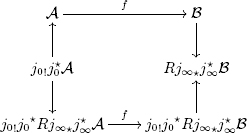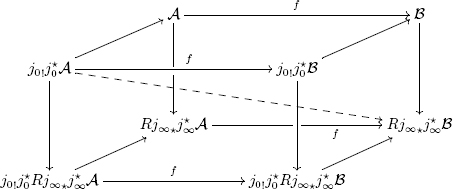CHAPTER 30
Appendix: Deligne’s Fibre Functor
In this appendix, we prove Theorem 3.1, i.e., we show that N ![]() !(N) := H0(A1/k, j0!N) is a fibre functor on the Tannakian category Pgeom of those perverse sheaves on Gm/k satisfying P, under middle convolution. Throughout this appendix, we work entirely over k, explicit mention of which we will omit. Thus we will write !(N) simply as H0(A1, j0!N). And when we wish to emphasize the roles of both 0 and ∞ in its definition, we will write it as !(N) := H0(P1, Rj∞?j0!N) = H0(P1, j0!Rj∞?N).
!(N) := H0(A1/k, j0!N) is a fibre functor on the Tannakian category Pgeom of those perverse sheaves on Gm/k satisfying P, under middle convolution. Throughout this appendix, we work entirely over k, explicit mention of which we will omit. Thus we will write !(N) simply as H0(A1, j0!N). And when we wish to emphasize the roles of both 0 and ∞ in its definition, we will write it as !(N) := H0(P1, Rj∞?j0!N) = H0(P1, j0!Rj∞?N).
It will be convenient to define, for any object M ∈ Dbc(Gm, Qℓ),
!(M) := H?(P1, j0!Rj∞?M) := ⊕i∈ZHi(P1, j0!Rj∞?M).
Lemma 30.1. If M is perverse, then Hi(P1, j0!Rj∞?M) = 0 for i ≠ 0, and dim H0(P1, j0!Rj∞?M) = χ(Gm, M)(= χc(Gm, M)). The functor M ![]() !(M) is an exact, faithful functor from the category Perv/Neg to the category of finite dimensional Qℓ-vector spaces.
!(M) is an exact, faithful functor from the category Perv/Neg to the category of finite dimensional Qℓ-vector spaces.
Proof. We can also write H?(P1, j0!Rj∞?M) as H?(A1, j0!M). Thus the first assertion was proven in Lemma 3.4. The dimension formula shows that !(M) = 0 if and only if M is negligible. The (not very) long exact cohomology sequence shows that ! is exact on Perv/Neg, and kills precisely the negligible objects.![]()
Suppose now that K and N are both in Pgeom. Then both K ?! N and K ?? N lie are perverse, and K?mid is, by definition, the image of the “forget supports” map K ?! N → K ?? N. By Gabber-Loeser [Ga-Loe, 3.6.4], both the kernel and cokernel of this map are negligible perverse sheaves, i.e., with χ = 0. Hence we get
Lemma 30.2. For K and N in Pgeom, under the natural maps
K ?! N ![]() K ?mid N
K ?mid N ![]() K ?? N,
K ?? N,
the induced maps on !’s are isomorphisms
!(K ?! N) ≅ !(K ?mid N) ≅ !(K ?? N).
Lemma 30.3. For M perverse, with M∨ := [x ![]() 1/x]? DM, !(M∨) is the linear dual of !(M).
1/x]? DM, !(M∨) is the linear dual of !(M).
Proof. Indeed,

Lemma 30.4. Given two objects K and N in Pgeom, we have the formula
dim(!(K) ⊗ !(N)) = dim !(K ?! N),
i.e., we have
χ(Gm, K) × χ(Gm, N) = χ(Gm, K ?! N).
Proof. Indeed, for mult : Gm × Gm → Gm the multiplication map, we have K ?! N = R(mult)!(K £ N). Thus

We now turn to the proof of Theorem 3.1. Given two objects K and N in Pgeom, we will define bifunctorial maps
!(K)⊗!(N) → !(K ?!N) ≅ !(K ?midN) ≅ !(K ?? N) → !(K)⊗!(N),
and show that their composite is the identity on !(K) ⊗ !(N). This is all we need: each of the five terms has dimension χ(Gm, K)×χ(Gm, N), so once the composite map is the identity, then the first map is injective and hence, for dimension reasons, an isomorphism. This isomorphism gives the required bifunctorial isomorphism
!(K) ⊗ !(N) ≅ !(K ?mid N).
We begin with the construction of the map
!(K) ⊗ !(N) → !(K ?! N).
Let us define
K := j0!Rj∞? K, N := j0!Rj∞? K.
Then we have
!(K) = H? (P1, K), !(N) = H? (P1, N),
and hence we have
!(K) ⊗ !(N) = H? (P1 × P1, K £ N).
We would like to extend the multiplication map Gm × Gm → Gm to a map P1 × P1 → P1. We cannot do this, but if we omit from P1 × P1 the two points (0, ∞) and (∞, 0), then we can define a map
π : P1 × P1 {(0, ∞), (∞, 0)} → P1,
given in homogeneous coordinates (A, B), (X, Y) on P1 × P1 by
((A, B), (X, Y)) ![]() (AX, BY).
(AX, BY).
Over the open set Gm in the target, we have the multiplication map Gm × Gm → Gm. Over the point 0 in the target, the fibre π–1(0) is the union of 0 × A1 with A1 × 0. Notice that because both K and N vanish at 0, the restriction of K £ N to π–1(0) vanishes. [The fibre π–1(∞) is the union of ∞× (P1 0) with (P1 0) ×∞, a fact we will use later.]
Because K £ N vanishes at both the points (0, ∞) and (∞, 0), we have an isomorphism
H?c(P1 × P1 {(0, ∞), (∞, 0)}, K £ N) ≅ H? (P1 × P1, K £ N).
Slightly less obvious is the following lemma.
Lemma 30.5. The restriction map in ordinary cohomology gives an isomorphism
H? (P1 × P1, K £ N) ≅ H? (P1 × P1 {(0, ∞), (∞, 0)}, K £ N).
Proof. It suffices to show that, denoting by i(0,∞) and i(∞,0) the inclusions, we have
Ri!(0, ∞)(K £ N) = 0, Ri!(∞, 0)(K £ N) = 0.
By duality, this is equivalent to
i?(0, ∞)(DK £ DN) = 0, i?(∞, 0)(DK £ DN) = 0.
But both DK = Rj0?j∞!DK and DN = Rj0?j∞!DN vanish at ∞, so their external product DK £ DN vanishes at both the points (0, ∞) and (∞, 0).
So our situation now is that we have isomorphisms
H?c(P1×P1{(0, ∞), (∞, 0)}, K£N) ≅ H? (P1×P1, K£N) = !(K)⊗!(N)
= H? (P1 × P1, K £ N) ≅ H? (P1 × P1 {(0, ∞), (∞, 0)}, K £ N),
in which the composite isomorphism is the “forget supports” map.
By the Leray spectral sequence for π in compact cohomology, we have
H?c(P1 × P1 {(0, ∞), (∞, 0)}, K £ N) = H? (P1, Rπ!(K £ N)).
And by the Leray spectral sequence in ordinary cohomology, we have
H? (P1 × P1 {(0, ∞), (∞, 0)}, K £ N) ≅ H? (P1, Rπ? (K £ N)).
So we have isomorphisms
H? (P1, Rπ!(K £ N)) ≅ !(K) ⊗ !(N) ≅ H? (P1, Rπ? (K £ N)),
in which the composite map is induced by the “forget supports” map Rπ!(K £ N) → Rπ? (K £ N).
There are two further isomorphisms we now take into account. As already observed above, K £ N vanishes on the fibre π–1(0), so by proper base change Rπ!(K£N) vanishes at 0, and hence the adjunction map j0!j0? → id induces an isomorphism
j0!j0? Rπ!(K £ N) ≅ Rπ!(K £ N).
We claim that, dually, the adjunction map id → Rj∞?j∞? induces an isomorphism
Rπ? (K £ N) ≅ Rj∞? j∞? Rπ? (K £ N).
Indeed, this is equivalent, by duality, to the statement that the adjunction map j∞!j∞? → id induces an isomorphism
j∞!j∞? Rπ!(DK £ DN) ≅ Rπ!(DK £ DN).
This holds, because both DK and DN vanish at ∞, so their external product DK £ DN vanishes on π–1(∞) (which we noted above is the union of ∞× (P1 0) with (P1 0) ×∞), and we get the assertion by proper base change.
Applying the adjunction map id → Rj∞ j∞?, we get a map
j0!j0? Rπ!(K £ N) → Rj∞?j∞? j0!j0? Rπ!(K £ N).
Here the cohomology of the target is !(K! N).
Applying the adjunction map j0!j0? → id, we get a map
j0!j0? j∞!j∞ Rπ? (DK £ DN) → j∞!j∞? Rπ? (DK £ DN).
Here the cohomology of the target is !(Kℓ N).
So the situation now is that we have a diagram of horizontal “forget supports” maps and vertical adjunction maps as follows. To make the diagram fit horizontally on the page, we write S for the subset {(0, ∞), (∞, 0)} of P1 × P1. Thus
P1 × P1 S := P1 × P1 {(0, ∞), (∞, 0)},
and our diagram is this.

So what must be shown is the commutativity of the following diagram.

To see what is going on, let us define
A := Rπ!(K £ N), B := Rπ? (K £ N),
and denote by f : A → B the “forget supports” map. Then the diagram in question is gotten by applying the functor C ![]() H? (P1, C) to the following diagram.
H? (P1, C) to the following diagram.

It suffices to show this this last diagram is commutative. To see this, we embed into the larger diagram, in which all the vertical and inward facing arrows are adjunctions, and all the horizontal arrows are induced by f.

A diagram chase shows that it suffices to show that the top face, the right side face, and the front face are each commutative. The top face is obtained by applying the adjunction j0!j?0 → id to the morphism f; it is commutative by the functoriality of adjunction. The right side face is obtained by applying the adjunction id → Rj∞? j?∞ to the (adjunction) morphism j0!j?0B → B, so is commutative by the functoriality of adjunction. And the front face is obtained by applying the same adjunction to the morphism j0!j?0(f), so is again commutative. [In fact, all six faces are commutative, always by the functoriality of adjunction.] This concludes the proof of Theorem 3.1.
